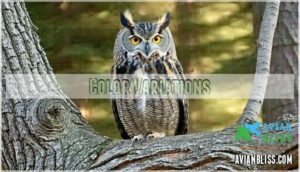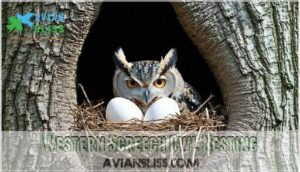This site is supported by our readers. We may earn a commission, at no cost to you, if you purchase through links.
 You’ll find the western screech owl camouflaged like a tiny feathered ghost against tree bark throughout western North America.
You’ll find the western screech owl camouflaged like a tiny feathered ghost against tree bark throughout western North America.
These 8-inch nocturnal hunters weigh just 3-6 ounces but pack serious predatory skills. They’re surprisingly adaptable, thriving in deserts, woodlands, parks, and suburban areas from sea level to 6,000 feet.
Their diet ranges from insects and scorpions to small mammals and birds. During daylight hours, they become masters of disguise, pressing against tree trunks with ear tufts raised and eyes nearly closed.
Their haunting "bouncing ball" call echoes through the night. Understanding their cryptic behavior reveals nature’s most elusive backyard neighbor, and learning about their habits can be a truly rewarding experience.
Table Of Contents
- Key Takeaways
- Western Screech Owl Description
- Western Screech Owl Habitat
- Western Screech Owl Behavior
- Western Screech Owl Diet
- Western Screech Owl Nesting
- Western Screech Owl Conservation
- Western Screech Owl Identification
- Frequently Asked Questions (FAQs)
- Are Western Screech-Owls rare?
- Are Western Screech-Owls aggressive?
- Where are Western Screech-Owls found?
- Do Western Screech-Owls come out during the day?
- Where do you put the Western Screech-Owl house?
- What states do Screech-Owls live in?
- Can western screech owls be kept as pets?
- How do western screech owls interact with humans?
- What are some unique adaptations of western screech owls?
- Do western screech owls migrate?
- Conclusion
Key Takeaways
- You’ll find these 8-inch owls are masters of disguise with cryptic coloration that perfectly matches tree bark, making them nearly invisible during daylight hours when they press against trunks with ear tufts raised.
- You can identify them by their distinctive "bouncing ball" call that echoes through the night – a series of hoots that speed up like a dropping ball, plus their bright yellow eyes and prominent ear tufts.
- You’ll discover they’re remarkably adaptable hunters that thrive everywhere from desert canyons to suburban parks, adjusting their diet seasonally from small mammals during breeding to insects in winter.
- You’ll need to provide nest boxes if you want to help them, as they depend on tree cavities for nesting and face challenges from habitat loss, vehicle strikes, and competition from larger owls.
Western Screech Owl Description
You’ll easily recognize the Western Screech Owl by its compact, robin-sized body and prominent ear tufts that give it a distinctive square-headed appearance.
This small owl displays remarkable color variation across its range, with Pacific Northwest birds showing more rufous tones while desert populations appear grayer.
Physical Characteristics
The western screech owl’s compact build resembles a robin-sized package with attitude.
You’ll notice prominent ear tufts crowning its square head, which sits on virtually no neck.
These owls measure 7.5-9.8 inches long with distinctive plumage patterns of mottled gray or brown streaking.
Their bill coloration shows a blackish base with yellow tips, while bright yellow eyes peer from their rounded face, showcasing their unique facial features.
Color Variations
Like a painter’s palette, you’ll find Western Screech Owls display remarkable color morphs across their range.
Regional plumage varies dramatically based on environmental influence and genetic basis, creating effective camouflage for different habitats.
- Pacific Northwest birds show rich rufous tones that blend with cedar and fir bark
- Desert Southwest populations display grayer bird coloration matching rocky terrain
- Rare reddish forms appear in coastal British Columbia and northwest Mexico
- Brown and gray color variations dominate most regions with streaked bird plumage
- Camouflage effectiveness depends on matching local tree bark and vegetation patterns
Size and Weight
You’ll find that western screech owls pack considerable presence into their compact frames.
These robin-sized birds measure 7.5-9.8 inches long with wingspans reaching 21.6-24.4 inches. Average dimensions show weights between 3.5-10.8 ounces, though most adults weigh 3-5 ounces.
Sexual dimorphism appears subtle – females grow slightly larger than males. Regional size variations occur across their range, with northern birds typically exceeding southern populations in overall measurements.
Their skeletal structure is optimized for flight, featuring lightweight, hollow bones, which is a key aspect of their compact frames, allowing for efficient use of their overall measurements, and contributing to their considerable presence.
Western Screech Owl Habitat
You’ll find western screech owls throughout western North America, from British Columbia down to Central America.
These adaptable birds thrive in diverse environments including desert canyons, oak woodlands, riparian areas, suburban parks, and even urban neighborhoods with mature trees, making them a notable presence in various western ecosystems.
Geographic Range
You’ll find the western screech owl across western North America, from southern Alaska down to Central America.
Regional subspecies vary substantially – Pacific Northwest birds show more rufous coloration while Desert Southwest populations appear grayer.
Their screech owl range spans the Rocky Mountains, extending east into parts of Texas and Kansas, adapting to climate impact and habitat fragmentation throughout these diverse regions.
They’re also found in Colorado, where they’re year-round residents alongside the Great Horned Owl.
Preferred Environments
Western Screech Owls thrive in diverse environments across their range.
These adaptable birds select habitats that provide essential resources for survival and reproduction:
From riparian zones to urban parks, these owls master the art of finding home where resources abound.
- Riparian Zones – Streamside woodlands with mesique and native vegetation offer abundant prey
- Oak Woodlands – Mature deciduous forests provide essential nesting cavities and hunting grounds
- Canyon Ecosystems – Rocky terrain with scattered trees creates ideal territory boundaries
You’ll find them from Pacific Northwest forests to Desert Southwest cacti groves, spanning elevational ranges up to 6,000 feet.
They’re known to nest in tree cavities.
Urban Vs Wild Habitats
You’ll find these owls adapting differently to urban environments versus their natural wild habitats.
Urban adaptation creates unique challenges that affect their survival and behavior patterns.
Their ability to thrive depends on available nesting sites.
| Habitat Type | Population Density | Breeding Success |
|---|---|---|
| Wild Forests | High (93% occupancy) | Favorable conditions |
| Urban Parks | Moderate (36% occupancy) | Reduced success |
| Fragmented Areas | Low ( |
Western Screech Owl Behavior
Western Screech Owls are primarily nocturnal hunters that become active at dusk and remain busy throughout the night.
You’ll find these small owls perching quietly on branches below the tree canopy, where they use their excellent hearing and eyesight to locate prey before swooping down silently to capture their target.
Nocturnal Activity
When darkness falls, western screech owls spring into action with remarkable precision.
These nocturnal birds possess extraordinary sensory adaptations, including acute hearing and enhanced night vision that make them masters of dusk activity.
You’ll rarely spot them during daylight hours when their light sensitivity keeps them tucked away in tree cavities.
Their hunting patterns begin at sunset and continue through the night, with peak activity occurring just after dusk when prey becomes most active, utilizing their night vision to navigate and hunt effectively.
Foraging Habits
You’ll spot these owls using a sit-and-wait strategy from low perches.
Prey selection shifts with seasonal diet changes – more mammals during breeding, insects in winter.
Their foraging range extends through riparian areas and urban foraging sites.
Hunting success peaks at dusk when owl diet includes mice, birds, and large insects.
Bird foraging behavior involves silent gliding attacks using sharp talons for feeding behavior.
Social Behavior
Monogamy forms the foundation of western screech owl relationships, with pairs maintaining year-round bonds through allopreening and courtship-feeding displays.
You’ll observe family structure during the five-week post-fledging period when juveniles stay close to parents.
Territory defense involves aggressive vocalizations and displays year-round, and communication calls include the distinctive "bouncing ball" sequence for mate attraction.
Juvenile dispersal occurs in late summer, with females traveling farther than males, which is an important aspect of their social structure.
Western Screech Owl Diet
You’ll find that western screech owls are opportunistic hunters with surprisingly varied diets that change with the seasons and available prey.
These adaptable predators consume everything from tiny insects to small mammals, adjusting their hunting strategies based on what’s most abundant in their territory, making them highly adaptable.
Common Prey Items
Among all prey items, Western screech owls primarily target small mammals like deer mice and rats, which form their dietary foundation.
You’ll find these birds also consume insects, small birds, lizards, snakes, frogs, and occasionally fish or crayfish.
Their opportunistic nature means bird prey and reptile intake supplement mammal consumption throughout the year.
Diet Variations
You’ll notice significant seasonal changes in their bird diet across different regions.
During breeding months, small mammals dominate their meals, while winter brings heavy insect consumption—up to 82% of stomach contents.
Regional diet varies dramatically based on prey availability.
Coastal populations feast on fish and crayfish, while desert birds focus on bird mammal catching and scavenging behavior from roadkill when opportunities arise, exhibiting a form of scavenging behavior.
Hunting Techniques
Western screech owls master perch hunting techniques that make them deadly nocturnal birds.
They use silent flight to approach unsuspecting targets.
Their exceptional prey detection abilities help them locate food in complete darkness through sound and movement.
- Perch hunting – They wait motionlessly on low branches, scanning for prey below
- Silent flight – Specialized feathers muffle wingbeats during hunting dives
- Opportunistic predation – They adapt hunting methods based on available prey species
- Seasonal variation – Summer focuses on insects, winter targets small mammals
- Prey detection – Sharp hearing pinpoints mouse rustling from remarkable distances
Western Screech Owl Nesting
You’ll discover that Western Screech Owls nest in tree cavities, from old woodpecker holes to natural tree hollows, typically 10-30 feet above ground.
They prefer sites with entrance holes just large enough to squeeze through, which helps keep larger predators away from their eggs and chicks.
Nesting Sites
Through careful cavity selection, you’ll find these owls choosing tree holes, nest boxes, and even old woodpecker sites.
They gather minimal nest materials like feathers or debris.
Site competition with other birds affects availability.
Urban nesting occurs in parks with suitable trees.
Reuse frequency varies, though pairs often return to successful locations for multiple breeding seasons.
Some species utilize abandoned nests of others for breeding.
Breeding Season
You’ll find that breeding season typically spans from February through July, though timing varies by location and climate conditions.
During this period, Western Screech Owls engage in complex mating rituals and establish territories.
- Mating rituals include courtship feeding and duet calling between pairs
- Clutch size ranges from 2-5 white eggs laid in tree cavities
- Incubation period lasts approximately 26-30 days with female handling most duties
Nest Box Provision
Installing nest boxes helps western screech owl populations when natural tree cavities are scarce.
You’ll need proper box dimensions with a 3-inch entrance size and untreated wood material choice.
Follow placement tips by mounting 10-30 feet high facing southeast.
Consider purchasing a pre-made owl house for easy installation.
Add predator guards below boxes to protect nesting owls from raccoons and cats.
Monitor regularly for successful owl nesting and habitat improvement.
Western Screech Owl Conservation
You’ll find that Western Screech Owls face several conservation challenges despite their current stable status.
These adaptable birds must deal with habitat loss, vehicle strikes, and various natural predators throughout their lives.
Lifespan in The Wild
Mortality factors in the wild slash these owls’ lifespan to just 1-8 years typically.
Average longevity hovers around 2-4 years due to predation by larger raptors and habitat loss.
Some may even consider purchasing owl-themed items.
Juvenile survival rates remain critically low during dispersal periods.
Wild threats include disease, food scarcity, and vehicle strikes that impact environmental stability for breeding populations, leading to a significant impact on their overall survival.
Conservation Status
The Western Screech Owl holds an IUCN Status of Least Concern globally, with Population Trends showing slight declines since 1966.
Despite owl conservation challenges from Habitat Loss and Climate Change, bird conservation efforts continue protecting critical habitats.
Pesticide Impact affects prey availability in some regions.
Conservation Efforts focus on preserving riparian forests and providing nest boxes where natural cavities are scarce.
Threats and Predators
You’ll encounter several threats that challenge western screech owl populations.
Habitat loss from development removes essential nesting sites, while vehicle strikes kill many owls near roads.
Rodenticides poison their prey, affecting owl health.
Larger owls like Great Horned Owls actively hunt them.
Climate change alters their ecosystem.
Bird threats include Barred Owls expanding westward, creating fierce competition for territory and resources.
The combination of these threats, including habitat loss, poses a significant challenge to the survival of western screech owl populations.
Western Screech Owl Identification
You’ll find that identifying Western Screech Owls requires a sharp eye for their masterful camouflage and distinctive features that set them apart from other small owls.
These compact birds blend seamlessly with tree bark through their mottled gray-brown plumage, prominent ear tufts, and unique facial patterns that make spotting them both challenging and rewarding.
Cryptic Coloration
Masters of disguise don’t reveal their secrets easily, but Western Screech Owls showcase cryptic coloration that’s pure evolutionary genius.
Nature’s ultimate vanishing act – these owls have perfected the art of disappearing in plain sight.
Their mottled gray and gray-brown plumage creates perfect habitat matching against tree bark.
Color morphs vary by region – darker birds blend with humid forests while paler ones match desert landscapes.
This regional camouflage provides exceptional predator avoidance and hunting advantages through seamless environmental integration.
Vocalizations
You’ll recognize western screech owl sounds by their signature "bouncing ball" call – a series of short hoots that speed up like a ball dropping.
Listen for their double trill songs too, where males use lower frequencies than females.
These owl calls serve as territorial calls during breeding season, while juveniles produce screeches and whimpers when hungry.
Unique Characteristics
You’ll spot several distinctive features that set this small owl apart from other species.
The western screech owl’s ear tufts aren’t always visible, creating identification challenges in the field. Regional morphs show remarkable variation, with plumage details ranging from rufous tones in Pacific forests to gray desert forms.
Key identifying features include:
- Sexual dimorphism – females noticeably larger than males
- Sensory adaptations – asymmetrical ear openings for precise sound location
- Feather patterns – intricate barring and streaking that perfectly mimics bark texture
This Megascops kennicottii displays cryptic coloration that makes them nearly invisible against tree trunks during daylight hours.
Frequently Asked Questions (FAQs)
Are Western Screech-Owls rare?
Western Screech-Owls aren’t rare at all. You’ll find them listed as "Least Concern" by conservation groups, and they’re actually described as "locally common" throughout their western range across diverse habitats.
Are Western Screech-Owls aggressive?
You’ll find they’re generally not aggressive toward humans but become quite territorial when defending their nests or hunting grounds.
They’ll aggressively pursue prey and show defensive behavior around their young during breeding season.
Where are Western Screech-Owls found?
From coast to coast, you’ll find these adaptable owls across western North America.
They inhabit diverse environments from Alaska’s coastal forests to Arizona’s desert cactus groves, thriving in wooded areas, urban parks, and riparian zones.
Do Western Screech-Owls come out during the day?
No, you won’t see Western Screech-Owls during daylight hours. They’re strictly nocturnal birds, becoming active at dusk and remaining so throughout the night until dawn.
Where do you put the Western Screech-Owl house?
Looking for the perfect spot for your feathered friend’s new home?
You’ll want to mount that nest box 8-20 feet high on a sturdy tree or pole, facing away from prevailing winds.
In wooded areas near forest edges where these nocturnal hunters naturally thrive.
What states do Screech-Owls live in?
You’ll find Western Screech-Owls across most western states, from Alaska down through California, Arizona, New Mexico, and Texas.
They’re also common in Colorado, Wyoming, Montana, Idaho, Nevada, Utah, Oregon, and Washington.
Can western screech owls be kept as pets?
You can’t legally keep western screech owls as pets.
They’re protected under federal wildlife laws, requiring special permits for possession.
These wild birds need specific diets, habitats, and veterinary care that’s extremely difficult to provide properly at home.
How do western screech owls interact with humans?
Out of sight, out of mind—you’ll rarely encounter these owls directly.
They’re naturally wary, staying hidden during daylight and avoiding human contact.
They tolerate urban areas but keep their distance from people, staying hidden during the day to maintain their distance.
What are some unique adaptations of western screech owls?
You’ll find western screech owls have remarkable camouflage abilities, blending perfectly with tree bark patterns. Their asymmetrical ear openings provide precise sound location for hunting small prey in darkness.
Do western screech owls migrate?
No, western screech owls don’t migrate.
They’re permanent residents throughout their range, staying in the same territories year-round.
You’ll find them consistently occupying their chosen habitats from Alaska to Central America.
Conclusion
Picture moonlight filtering through branches as a small, cryptic shadow blends seamlessly with tree bark.
The western screech owl’s remarkable adaptability and specialized hunting skills make it one of nature’s most successful small predators.
You’ve learned how these nocturnal hunters thrive across diverse habitats, from desert canyons to suburban neighborhoods.
Whether you’re hoping to spot one in your backyard or simply appreciate their ecological importance, understanding the western screech owl’s behavior enriches your connection with the natural world around you, highlighting their ability to survive in various environments due to their specialized hunting skills and nocturnal hunters nature.













